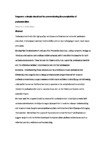Tangrams: a simple visual tool for communicating the complexities of professionalism
| dc.contributor.author | Neve, Hilary | |
| dc.contributor.author | Hanks, Sally | |
| dc.date.accessioned | 2022-01-14T17:30:39Z | |
| dc.date.available | 2022-01-14T17:30:39Z | |
| dc.date.issued | 2022-01-14 | |
| dc.identifier.issn | 2312-7996 | |
| dc.identifier.issn | 2312-7996 | |
| dc.identifier.uri | http://hdl.handle.net/10026.1/18559 | |
| dc.description.abstract |
<ns4:p>Professionalism is vital for high quality healthcare and fundamental to health profession education. It is however complex, hard to define and can be challenging to teach, learn about and assess.</ns4:p><ns4:p> We describe the development and use of an innovative visual tool, using a tangram analogy, to introduce and explore core professionalism concepts, which are often troublesome for both learners and educators. These include the hidden curriculum, capability, professional identity and the difference between unprofessionalism and high professional standards. Understanding these concepts can help individuals to see professionalism differently, encourage faculty to design professionalism programmes which focus on professional excellence, support assessors to feel more confident in identifying and addressing underperformance and facilitate learners to appreciate the complexity and uncertainty inherent in professionalism and to become more alert to the hidden curriculum and its potential impact.</ns4:p><ns4:p> We have used the tangram model to educate for professionalism in multiple contexts with learners and educators. Participants regularly report that it leads to a deeper understanding and important new insights around professionalism and helps them identify ways of changing their practice. We believe this approach has relevance across the health professions and suggest ways it could be further developed to explore wider professionalism issues such as reflective practice, resilience and teamworking.</ns4:p> | |
| dc.format.extent | 2-2 | |
| dc.language | en | |
| dc.language.iso | en | |
| dc.publisher | F1000 Research Ltd | |
| dc.subject | Clinical Research | |
| dc.title | Tangrams: a simple visual tool for communicating the complexities of professionalism | |
| dc.type | journal-article | |
| plymouth.volume | 12 | |
| plymouth.publication-status | Published online | |
| plymouth.journal | MedEdPublish | |
| dc.identifier.doi | 10.12688/mep.17558.1 | |
| plymouth.organisational-group | /Plymouth | |
| plymouth.organisational-group | /Plymouth/Faculty of Health | |
| plymouth.organisational-group | /Plymouth/Faculty of Health/Peninsula Dental School | |
| plymouth.organisational-group | /Plymouth/Users by role | |
| plymouth.organisational-group | /Plymouth/Users by role/Academics | |
| dcterms.dateAccepted | 2021-12-13 | |
| dc.rights.embargodate | 2022-1-21 | |
| dc.identifier.eissn | 2312-7996 | |
| dc.rights.embargoperiod | Not known | |
| rioxxterms.versionofrecord | 10.12688/mep.17558.1 | |
| rioxxterms.licenseref.uri | http://www.rioxx.net/licenses/all-rights-reserved | |
| rioxxterms.licenseref.startdate | 2022-01-14 | |
| rioxxterms.type | Journal Article/Review |


